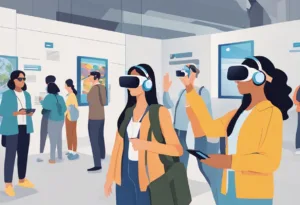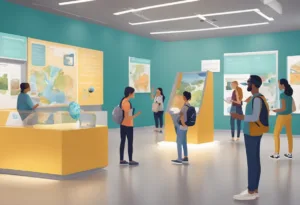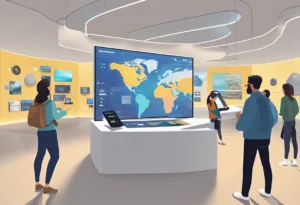Augmented reality technology has revolutionized the way we interact with the world around us, and museums are no exception. Augmented reality museums provide visitors with an innovative and immersive experience that brings exhibits and artifacts to life. In this article, I will discuss the concept of augmented reality museum and share with you 15 use cases of augmented reality in museums
With augmented reality, museums can take visitors on a journey through time and space, allowing them to explore historical artifacts and artworks in new and exciting ways. Visitors can use their devices to access additional information about exhibits, interact with virtual objects, and even create their own augmented reality experiences. Augmented reality museums are an excellent way to engage younger generations with history and culture, making learning fun and accessible.
Concept of Museums with Augmented Reality
Augmented Reality (AR) is a technology that superimposes digital images onto the real world. AR has been increasingly used in museums to enhance the museum experience and make it more interactive. AR is changing the way people interact with heritage sites and cultural artifacts.
Role of Augmented reality in museum
AR has the potential to provide visitors with a more immersive experience in museums. By using AR, visitors can see and interact with digital objects that are superimposed onto the real world. AR can also be used to provide visitors with more information about the artifacts they are viewing. For example, visitors can use AR to see how an artifact would have looked like when it was new. AR can also be used to create interactive exhibits that allow visitors to explore and learn about the exhibits in a more engaging way.
Difference between AR museums and traditional museum
AR museums are different from traditional museums in several ways. Traditional museums are static, and visitors are usually limited to viewing artifacts behind glass cases. AR museums, on the other hand, are interactive, and visitors can interact with digital objects that are superimposed onto the real world. AR museums also provide visitors with more information about the artifacts they are viewing, and allow them to explore the exhibits in a more engaging way.
AR technology is transforming the way people interact with museums and heritage sites. By using AR, museums can provide visitors with a more immersive and interactive experience. AR museums are different from traditional museums in several ways, and offer visitors a unique and engaging way to learn about history and culture.
Use Cases of Augmented Reality in Museums

- Virtual tours and walkthroughs
- Interactive exhibits
- Educational games and scavenger hunts
- Artifact restoration visualization
- Sign language interpretation
- Multilingual support
- Visitor navigation and wayfinding
- Enhanced art visualization
- Historical reenactments
- Augmented reality guides and docents
- Visitor engagement analytics
- Social media integration
- Personalized content delivery
- Immersive storytelling
- Accessibility features for visitors with disabilities
Virtual Tours and Walkthroughs
Augmented reality enables museums to offer virtual tours and walkthroughs, allowing visitors to explore spaces and exhibits remotely or enhance their in-person visit. These AR tours can provide a guided experience, complete with narration and additional contextual information, making them an effective marketing tool by giving a preview of what visitors can expect.
Interactive Exhibits
Museums use AR to create interactive exhibits where visitors can engage with displays in a more meaningful way. By scanning QR codes or using AR apps, visitors can unlock additional content, such as videos, animations, or 3D models, which can be used in marketing to showcase the museum’s innovative approach to exhibition design.
Educational Games and Scavenger Hunts
AR transforms the museum experience by incorporating educational games and scavenger hunts. These activities encourage visitors to explore and learn about exhibits in a fun and competitive manner. This gamified approach is often highlighted in marketing materials to attract families and younger audiences seeking entertainment in addition to education.
Artifact Restoration Visualization
AR allows museums to show visitors what artifacts would have looked like in their original state. By overlaying restored images or structures onto damaged artifacts, visitors can appreciate the historical significance and craftsmanship. Museums can market this use case to attract those interested in conservation and archaeology.
Sign Language Interpretation
Museums are using AR to provide sign language interpretation for visitors who are deaf or hard of hearing. This inclusive feature can be a strong marketing point, emphasizing the museum’s commitment to accessibility and diversity.
Multilingual Support
AR applications can offer content in multiple languages, making the museum experience more accessible to non-native speakers. This feature can be a key marketing aspect, especially for museums in multicultural cities or those with a significant number of international visitors.
Visitor Navigation and Wayfinding
AR can assist with navigation and wayfinding within the museum, helping visitors to locate exhibits and amenities easily. This use case can be promoted in marketing to highlight the ease of visitor experience, especially in larger institutions.
Enhanced Art Visualization
AR can enhance the visualization of art by providing deeper insights into the artwork, such as showing the layers of paint or the artist’s process. This feature can attract art enthusiasts and can be used in marketing to differentiate the museum’s offerings.
Historical Reenactments
Museums can use AR to create historical reenactments, bringing history to life for visitors. This can be a unique selling point in marketing campaigns, appealing to those interested in experiencing history in an immersive way.
Augmented Reality Guides and Docents
AR guides and docents can provide personalized tours and information, offering a high-tech alternative to traditional audio guides. This use case can be marketed to tech-savvy visitors who prefer digital interaction.
Visitor Engagement Analytics
AR apps can track visitor engagement and provide valuable analytics. Museums can use this data to improve the visitor experience and tailor their marketing strategies to target audiences more effectively.
Social Media Integration
AR experiences are often designed to be shareable on social media, providing visitors with unique photo and video opportunities. This integration can be leveraged in marketing to encourage visitors to share their experiences and attract new audiences.
Personalized Content Delivery
AR allows museums to deliver personalized content based on visitor preferences and behavior. This can enhance the visitor experience and be used in marketing to promote a tailored and unique museum visit.
Immersive Storytelling
With AR, museums can create immersive storytelling experiences that transport visitors to different times or places. This can be a compelling feature for marketing, as it promises a unique and memorable visit.
Accessibility Features for Visitors with Disabilities
AR can provide accessibility features, such as visual or auditory enhancements, to make exhibits more accessible to visitors with disabilities. Museums can highlight these features in their marketing to show their commitment to inclusivity and ensure that all visitors can enjoy their collections.
Implementing AR in Museums

Augmented Reality (AR) technology has revolutionized the way museums display and engage visitors with their exhibits. By implementing AR in museums, visitors can experience a new dimension of interaction and engagement with the content.
AR Apps and Devices
AR technology can be accessed through smartphones and tablets, making it accessible to most visitors. Some museums have also started providing AR devices that visitors can use during their visit. These devices can be rented or borrowed from the museum and come pre-loaded with AR apps that enhance the visitor experience.
Content Creation for AR
Creating content for AR requires a different approach than traditional museum exhibits. The content needs to be designed in 3D and optimized for AR devices. Museums can hire AR content creators to design and develop AR experiences for their exhibits.
Visitor Interaction and Engagement
AR technology allows visitors to interact with exhibits in a more immersive and engaging way. Visitors can explore exhibits in 3D, view additional information, and even interact with virtual objects. This enhances the visitor experience and creates a more memorable experience.
Implementing AR in museums can enhance the visitor experience and provide a new dimension of interaction and engagement with exhibits. Museums can use AR apps and devices, hire AR content creators, and provide visitors with a more immersive and engaging experience.
Impact of AR on Museum Learning and Accessibility

Augmented Reality (AR) has had a significant impact on museum learning and accessibility. AR technology can enhance the educational value of museums by providing visitors with additional information and annotations about the collections.
Enhancing Educational Value
AR technology provides an interactive and engaging way to learn about museum collections. Visitors can use their smartphones or tablets to scan exhibits and access additional information, such as historical facts, multimedia content, and 3D models. This approach to learning can help visitors to better understand complex concepts and appreciate the historical significance of the exhibits.
Moreover, AR can make museum learning more accessible to people with disabilities. For example, visitors with visual impairments can use AR to access audio descriptions of exhibits, while visitors with hearing impairments can use AR to access visual annotations.
Making Museums Accessible to All
AR technology can also make museums more accessible to all visitors. AR can provide visitors with a virtual guide that can help them navigate the museum and locate exhibits. This guide can provide visitors with information about the exhibits, as well as directions to accessible entrances, restrooms, and other facilities.
AR can also help visitors with mobility impairments to explore the museum. Visitors can use AR to access virtual exhibits that are not accessible due to physical barriers, such as stairs or narrow doorways. This approach can help visitors to experience the museum in a more immersive and inclusive way.
Case Studies of Augmented Reality in Museums

National Museum of Singapore: Story of the Forest
The National Museum of Singapore’s Story of the Forest exhibition is a perfect example of how AR technology can be used in cultural institutions. The exhibition uses AR to create an immersive experience for visitors, allowing them to explore the forest in a virtual environment. Visitors can use their smartphones to scan QR codes and access the AR experience, which includes interactive features such as sound effects and animations.
The AR experience at the Story of the Forest exhibition is an excellent way to engage visitors and provide them with an educational experience. The use of AR technology has made the exhibition more interactive and engaging, allowing visitors to explore the forest in a way that would not have been possible otherwise.
Smithsonian Institution: Skin and Bones
The Smithsonian Institution’s Skin and Bones exhibition is another excellent example of how AR technology can be used in museums. The exhibition uses AR to allow visitors to explore the anatomy of animals in a virtual environment. Visitors can use their smartphones to scan QR codes and access the AR experience, which includes interactive features such as 3D models and animations.
The use of AR technology in the Skin and Bones exhibition has made the exhibition more engaging and educational. Visitors can explore the anatomy of animals in a way that would not have been possible otherwise. The AR experience has also made the exhibition more accessible, allowing visitors to interact with the exhibits in a way that suits their learning style.
AR technology has revolutionized the way cultural institutions such as museums engage with their visitors. The use of AR technology in exhibitions such as the Story of the Forest and Skin and Bones has made the exhibitions more interactive and engaging, providing visitors with an educational experience that they will not forget.
5 Augmented Reality Museum Experiences
Augmented reality technology has transformed the way we experience museums. Here are five examples of augmented reality museum experiences that showcase the possibilities of this innovative technology.
1. The Smithsonian National Museum of Natural History, Washington DC
The Smithsonian National Museum of Natural History introduced an AR app called “Skin and Bones”. The Bone Hall, a display showcasing about 300 century-old skeletons of vertebrates, was always worth a visit. But with the “Skin and Bones” app, visitors can now see the animals come to life with animations and sound effects. This app has made the museum experience more engaging and educational for visitors of all ages.
2. The National Gallery, London
The National Gallery in London has created an AR experience that brings their collections to life beyond the walls of the museum. Visitors can access the AR experience through their phones and explore the collections of the National Gallery, National Portrait Gallery, and Royal Academy of Arts. This AR experience has allowed the museum to reach a wider audience and provide an innovative way to engage with art.
3. The Museum of London
The Museum of London has implemented an AR experience called “Streetmuseum”. This app allows visitors to explore the city’s history by overlaying historical images onto the modern-day cityscape. Visitors can see how London has changed over time and learn about the city’s rich history in a new and immersive way.
4. The Louvre, Paris
The Louvre has implemented an AR experience called “Mona Lisa: Beyond the Glass”. This app allows visitors to explore the famous painting in detail and learn about its history and significance. The AR experience provides a unique and interactive way to engage with one of the world’s most famous paintings.
5. The Museum of Modern Art, New York
The Museum of Modern Art in New York has implemented an AR experience called “MoMA AR”. This app allows visitors to explore the museum’s collection in a new and interactive way. Visitors can use the app to scan artwork and access additional information, such as artist bios and multimedia content. The app also includes interactive exhibits and games that engage visitors in a fun and educational way.
Augmented reality technology has opened up new possibilities for museums to engage with visitors and provide an innovative and educational experience. However, implementing AR experiences also poses challenges, such as the need for investment in technology and the need to balance the use of technology with traditional museum experiences. Nonetheless, the future of augmented reality in museums is promising, and we can expect to see more innovative AR experiences in the years to come.
Frequently Asked Questions
How can museums enhance visitor experiences with augmented reality?
Museums can enhance visitor experiences with augmented reality by providing them with an immersive and interactive experience. By using AR technology, museums can bring exhibits to life by adding digital elements to physical objects. This can help visitors to better understand and appreciate the exhibits, as well as engage with them in a more meaningful way.
What are the benefits of using augmented reality in art exhibitions?
The benefits of using augmented reality in art exhibitions include providing visitors with a unique and engaging experience, as well as allowing them to interact with the art in new and exciting ways. AR can also provide additional context and information about the art, which can help visitors to better understand and appreciate it.
Which museums have implemented augmented reality tours?
Many museums around the world have implemented augmented reality tours, including the Louvre in Paris, the British Museum in London, and the Smithsonian National Museum of Natural History in Washington, D.C. These tours allow visitors to explore the museum in a more interactive and engaging way, and provide them with additional information and context about the exhibits.
How does augmented reality change the way we interact with museum exhibits?
Augmented reality changes the way we interact with museum exhibits by providing us with a more immersive and interactive experience. With AR, we can explore exhibits in new and exciting ways, and engage with them in a more meaningful way. AR also provides us with additional information and context about the exhibits, which can help us to better understand and appreciate them.
Are there mobile apps available for augmented reality museum experiences?
Yes, there are many mobile apps available for augmented reality museum experiences. These apps allow visitors to explore exhibits in a more interactive and engaging way, and provide them with additional information and context about the exhibits. Some popular AR museum apps include Smartify, Google Arts & Culture, and ARtGlass.
What are the differences between virtual reality and augmented reality in the context of museums?
Virtual reality (VR) and augmented reality (AR) are both technologies that can be used in museums, but they have different applications. VR provides a fully immersive experience, where users are transported to a completely digital environment. AR, on the other hand, overlays digital elements onto the physical world. In the context of museums, AR is often used to enhance exhibits and provide additional information and context, while VR is used to create fully immersive experiences.













